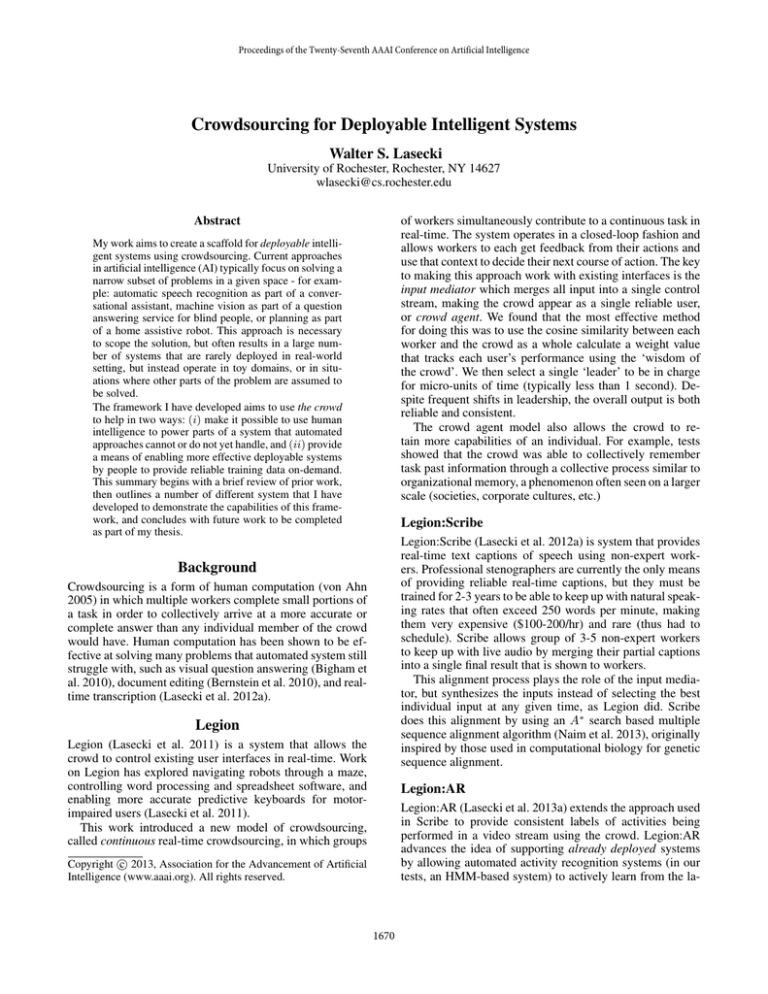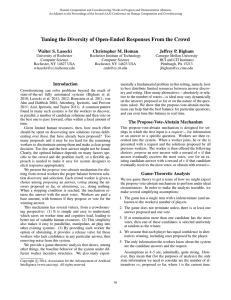
Proceedings of the Twenty-Seventh AAAI Conference on Artificial Intelligence
Crowdsourcing for Deployable Intelligent Systems
Walter S. Lasecki
University of Rochester, Rochester, NY 14627
wlasecki@cs.rochester.edu
Abstract
of workers simultaneously contribute to a continuous task in
real-time. The system operates in a closed-loop fashion and
allows workers to each get feedback from their actions and
use that context to decide their next course of action. The key
to making this approach work with existing interfaces is the
input mediator which merges all input into a single control
stream, making the crowd appear as a single reliable user,
or crowd agent. We found that the most effective method
for doing this was to use the cosine similarity between each
worker and the crowd as a whole calculate a weight value
that tracks each user’s performance using the ‘wisdom of
the crowd’. We then select a single ‘leader’ to be in charge
for micro-units of time (typically less than 1 second). Despite frequent shifts in leadership, the overall output is both
reliable and consistent.
The crowd agent model also allows the crowd to retain more capabilities of an individual. For example, tests
showed that the crowd was able to collectively remember
task past information through a collective process similar to
organizational memory, a phenomenon often seen on a larger
scale (societies, corporate cultures, etc.)
My work aims to create a scaffold for deployable intelligent systems using crowdsourcing. Current approaches
in artificial intelligence (AI) typically focus on solving a
narrow subset of problems in a given space - for example: automatic speech recognition as part of a conversational assistant, machine vision as part of a question
answering service for blind people, or planning as part
of a home assistive robot. This approach is necessary
to scope the solution, but often results in a large number of systems that are rarely deployed in real-world
setting, but instead operate in toy domains, or in situations where other parts of the problem are assumed to
be solved.
The framework I have developed aims to use the crowd
to help in two ways: (i) make it possible to use human
intelligence to power parts of a system that automated
approaches cannot or do not yet handle, and (ii) provide
a means of enabling more effective deployable systems
by people to provide reliable training data on-demand.
This summary begins with a brief review of prior work,
then outlines a number of different system that I have
developed to demonstrate the capabilities of this framework, and concludes with future work to be completed
as part of my thesis.
Legion:Scribe
Legion:Scribe (Lasecki et al. 2012a) is system that provides
real-time text captions of speech using non-expert workers. Professional stenographers are currently the only means
of providing reliable real-time captions, but they must be
trained for 2-3 years to be able to keep up with natural speaking rates that often exceed 250 words per minute, making
them very expensive ($100-200/hr) and rare (thus had to
schedule). Scribe allows group of 3-5 non-expert workers
to keep up with live audio by merging their partial captions
into a single final result that is shown to workers.
This alignment process plays the role of the input mediator, but synthesizes the inputs instead of selecting the best
individual input at any given time, as Legion did. Scribe
does this alignment by using an A∗ search based multiple
sequence alignment algorithm (Naim et al. 2013), originally
inspired by those used in computational biology for genetic
sequence alignment.
Background
Crowdsourcing is a form of human computation (von Ahn
2005) in which multiple workers complete small portions of
a task in order to collectively arrive at a more accurate or
complete answer than any individual member of the crowd
would have. Human computation has been shown to be effective at solving many problems that automated system still
struggle with, such as visual question answering (Bigham et
al. 2010), document editing (Bernstein et al. 2010), and realtime transcription (Lasecki et al. 2012a).
Legion
Legion (Lasecki et al. 2011) is a system that allows the
crowd to control existing user interfaces in real-time. Work
on Legion has explored navigating robots through a maze,
controlling word processing and spreadsheet software, and
enabling more accurate predictive keyboards for motorimpaired users (Lasecki et al. 2011).
This work introduced a new model of crowdsourcing,
called continuous real-time crowdsourcing, in which groups
Legion:AR
Legion:AR (Lasecki et al. 2013a) extends the approach used
in Scribe to provide consistent labels of activities being
performed in a video stream using the crowd. Legion:AR
advances the idea of supporting already deployed systems
by allowing automated activity recognition systems (in our
tests, an HMM-based system) to actively learn from the la-
c 2013, Association for the Advancement of Artificial
Copyright Intelligence (www.aaai.org). All rights reserved.
1670
combination process. For instance, in the case of Scribe, humans tend to be very good at capturing short, predictable
words, where ASR tends to be better at capturing longer,
more complex words due to their unique phoneme profile.
Using this, we can create a weighting scheme to favor each
in their specialty. Next, I will focus on learning these in more
general domains from features of the answers.
Finally, we can use the crowd to generating on-the-fly
training data in ways never considered before. For example, we are developing ARchitect to investigate formalizing
activity recognition tasks by extract STRIPS-style pre and
post conditions from crowd labels of video with the help of
multiple layers of clarifying responses and knowledge association (Lasecki et al. 2013b).
bels produced by the crowd. Whenever the automated system is unsure of its label for a given activity, a request is issued to Legion:AR and a label stream begins within seconds.
Our goal was to reduce the training overhead involved in releasing robust activity recognition systems, and handle situations which are difficult or impossible to plan for a prior.
Chorus
Chorus (Lasecki et al. 2012b) is a system that allows the
crowd to collectively act as a conversational parter. Chorus uses an incentive mechanism to encourage workers to
propose and vote on potential responses to the user. To
help support multi-session memory of the user even with an
ever-changing workforce, Chorus includes a shared memory
space which uses the crowd to extract facts that might need
to be recalled later. Using this two-part system, we developed Chorus:Assist, an intelligent assistance that is able to
return answers or ask followup questions about information
gathering tasks. Chorus:Assist was able to consistently and
correctly answer over 84% of user prompts, both primary
queries and requests for details or followup information.
Chorus also holds the promise of being an unprecedented
training framework for automated conversational agents,
who can be used as workers just as members of the crowd
can be. This allows AI systems to both learn from the conversation they observe, both the accepted content, and that
which was deemed by the crowd to be not worth presenting
to users. It also allows systems to propose possible responses
that will be filtered out by the crowd if incorrect. This means
that even still-untrained systems do not effect the user’s perception of the assistant. Additionally, as the system learns,
more of the responsibility can be handed automatically – allowing Chorus to smoothly scale from being entirely crowdpowered, to being entirely automated.
Conclusion
In my work, I have presented a model of crowdsourcing
which can be used to create deployable intelligent systems
in real-world domains that leverage the strengths of artificial intelligence while filling in the gaps with human intelligence. Our general framework also allows intelligent agents
to learn in real-world domains without the same risk of failing at a critical task, due to the crowd’s supervision. This
enables systems that can be deployed today using the crowd,
and scale towards fully automated in the future.
References
Bernstein, M. S.; Little, G.; Miller, R. C.; Hartmann, B.; Ackerman,
M. S.; Karger, D. R.; Crowell, D.; and Panovich, K. 2010. Soylent:
a word processor with a crowd inside. In Proc. of the Symp. on
User interface software and technology, UIST ’10, 313–322.
Bigham, J. P.; Jayant, C.; Ji, H.; Little, G.; Miller, A.; Miller, R. C.;
Miller, R.; Tatarowicz, A.; White, B.; White, S.; and Yeh, T. 2010.
Vizwiz: nearly real-time answers to visual questions. In Proc. of
the Symp. on User interface software and technology, UIST ’10,
333–342.
Lasecki, W.; Murray, K.; White, S.; Miller, R. C.; and Bigham, J. P.
2011. Real-time crowd control of existing interfaces. In Proc. of
the Symp. on User interface software and technology, UIST ’11,
23–32.
Lasecki, W. S.; Miller, C. D.; Sadilek, A.; Abumoussa, A.; Borrello, D.; Kushalnagar, R.; and Bigham, J. P. 2012a. Real-time
captioning by groups of non-experts. In Proc. of the Symp. on User
Interface Software and Technology (UIST 2012).
Lasecki, W.; Kulkarni, A.; Wesley, R.; Nichols, J.; Hu, C.; Allen,
J.; and Bigham, J. 2012b. Chorus: Letting the crowd speak with
one voice. In University of Rochester Technical Report, 1–10.
Lasecki, W. S.; Song, Y. C.; Kautz, H.; and Bigham, J. P. 2013a.
Real-time crowd labeling for deployable activity recognition. In
Proc. of the Conf. on Computer supported cooperative work,
CSCW 2013.
Lasecki, W.; Weingard, L.; Bigham, J.; and Ferguson, G. 2013b.
Crowd formalization of action conditions. In Student Abstracts at
the AAAI Conf. on Artificial Intelligence, In submission.
Naim, I.; Lasecki; W.S., Bigham, J.; and Gildea, D. 2013. Text
alignment for real-time crowd captioning. In North American
Chapter of the Association for Computational Linguistics Conf.,
In Submission.
von Ahn, L. 2005. Human Computation. Ph.D. Dissertation,
Carnegie Mellon University, Pittsburgh, PA.
Chorus:View
Chorus:View uses the conversational interface pioneered in
Chorus:Assist to help blind and low-vision users answer
visual questions about the environment around them using streaming video. Because the interaction is continuous,
the crowd maintains context and can give real-time feedback, unlike prior single-questions systems such as VizWiz
(Bigham et al. 2010). In initial tests, Chorus:View shows
significant improvement over VizWiz (several seconds compared to several minutes) in tasks where information had to
be sought out, such as reading details on food packages.
Future Work
My work thus far has established a set of approaches to recover reliable, consistent responses from the crowd, and a
framework that allows the crowd to act as a single agent and
source of guidance to existing AI systems. In future work,
my goal is to focus on the development of hybrid intelligence systems more seamlessly blend artificial and human
intelligence to create systems that can be deployed now and
train automated systems in situ to take over control later.
First, I will focus on creating models that take advantage
of asymmetries in human and machine skillets in the input
1671



